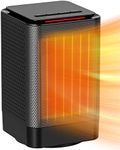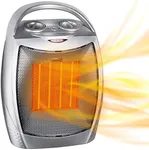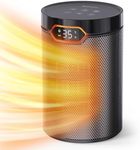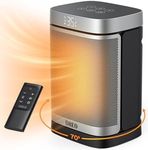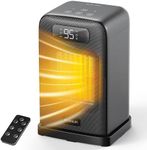Buying Guide for the Best Safest Heater For Baby Room
Choosing a heater for a baby's room is all about ensuring safety, comfort, and a healthy environment. Babies are more sensitive to temperature changes and air quality, so it's important to pick a heater that not only keeps the room warm but also minimizes risks like burns, overheating, or dry air. When shopping, focus on features that enhance safety and make it easy to maintain a consistent, gentle warmth. Understanding the key specifications will help you make a confident and informed choice.Safety FeaturesSafety features are the built-in protections that help prevent accidents and injuries. For a baby's room, look for heaters with cool-to-touch exteriors, tip-over protection (which turns the heater off if it falls), and overheat protection (which shuts it off if it gets too hot). Some heaters also have child locks to prevent curious hands from changing settings. These features are crucial because babies can be unpredictable, and you want to minimize any risk of burns or fire. Always prioritize models with multiple safety certifications and features, especially if the heater will be used unsupervised.
Type of HeaterThe type of heater determines how it produces and distributes heat. Common types include oil-filled radiators, ceramic heaters, and panel heaters. Oil-filled radiators are often recommended for baby rooms because they provide steady, gentle heat and their surfaces don't get extremely hot. Ceramic heaters warm up quickly and often have fans, but some can get hot to the touch. Panel heaters are slim and can be wall-mounted, keeping them out of reach. When choosing, consider how the heater will be used—if you want something that stays warm for hours and is safe to touch, oil-filled or wall-mounted panel heaters are usually best for nurseries.
Temperature ControlTemperature control refers to how precisely you can set and maintain the room's warmth. Heaters with adjustable thermostats and digital displays allow you to set an exact temperature, which is important for a baby's comfort and safety. Some models have programmable timers or eco-modes to maintain a steady temperature without overheating. For a baby's room, it's best to choose a heater that lets you set a specific temperature (ideally between 18-21°C or 64-70°F) and keeps it consistent, as babies are sensitive to both cold and excessive heat.
Noise LevelNoise level is how much sound the heater makes while operating. Some heaters, especially those with fans, can be noisy and may disturb a baby's sleep. Oil-filled radiators and panel heaters are usually very quiet, making them ideal for nurseries. If your baby is a light sleeper, look for heaters labeled as 'silent' or 'ultra-quiet.' Always consider your child's sleep habits and the room's environment when deciding how much noise is acceptable.
Air Quality ImpactAir quality impact refers to how the heater affects the moisture and cleanliness of the air. Some heaters, especially those with exposed heating elements or fans, can dry out the air, which may irritate a baby's skin or respiratory system. Oil-filled and panel heaters are less likely to dry the air. If you live in a dry climate or notice your baby's skin getting dry, consider a heater that doesn't reduce humidity, or use a humidifier alongside it. Always monitor the room's air quality to ensure your baby's comfort and health.
Size and PlacementSize and placement refer to the physical dimensions of the heater and where it can be safely positioned in the room. A compact heater is easier to fit in small spaces, but it still needs to be powerful enough to warm the entire room. Wall-mounted heaters are a good choice for keeping the unit out of reach. Always place the heater away from cribs, bedding, and curtains, and ensure there's enough space around it for air to circulate. Think about your room layout and choose a heater that fits safely and effectively.
